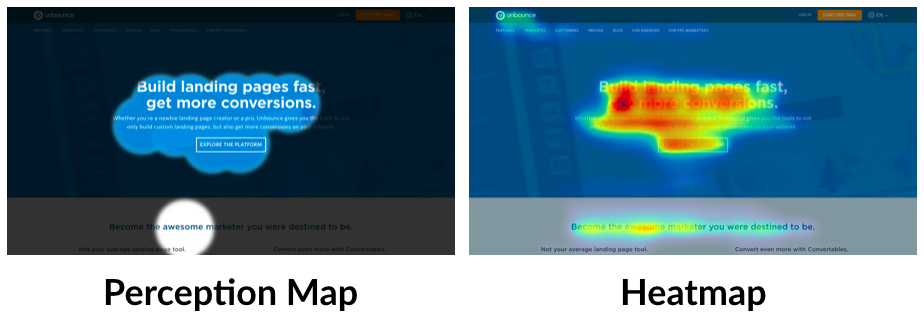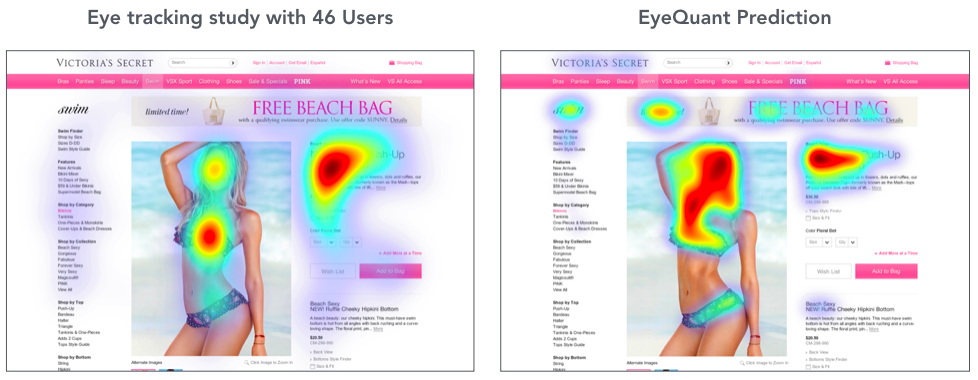We value your privacy
This website uses cookies to ensure you get the best experience on our website.
 Skip to main content
Skip to main content
This website uses cookies to ensure you get the best experience on our website.
Website heatmaps have been a popular analysis tool for years, and there are dozens of different vendors out there offering some form of heatmaps – whether they’re measuring clicks, mouse movements, or other kinds of engagement.
One of these options is commonly referred to as predictive or algorithmic eye tracking heatmaps, and unfortunately, this kind of heatmap is probably one of the most misunderstood tools for website analysis. In this post, we’ll try to shed some light on this interesting approach.
Predictive eye tracking uses algorithms to simulate or approximate how users are looking at your website, and deliver heat maps and other data visualizations to help you make design decisions. Today’s best predictive models are able to accurately represent how a typical user would scan a page when they first arrive, typically limited to the first 3-5 seconds.

For that reason, you can think of it as a basic analysis of the visual hierarchy of your page, and a useful insight into what users are most likely looking at before the point when they’d take meaningful action with their mouse.
That also means that the results shouldn’t look the same as your mouse tracking or click heatmaps, so predictive analysis should complement your other tools, not replace them.
Some predictive approaches are trustworthy – others not so much.
The first question many people ask when they hear about predictive heatmapping is, of course, about reliability. Can you really trust a simulated eye tracking study enough to make business decisions based on it?
The vast majority of companies offering predictive heat map service are using only slightly modified versions of decades-old open-source prediction algorithms. Those algorithms are often not modified to specifically predict how people look at websites. This is especially true of the cheaper options.
However, a premium category exists that can indeed offer meaningful predictive insights specifically for digital content. At EyeQuant, we collect real website eye-tracking data from lab-based studies where participants wear an eye tracking device, and we apply machine learning to that data to scientifically understand which design factors actually drive eye movements.

Image Source: EyeQuant Accuracy Information and Validation Studies
When you find a solution that you trust, this technology can be a powerful tool. For example, Groupon famously used EyeQuant to increase the conversion rate of a key landing page by 52%.
The designers, marketers and optimization strategists that are successful with predictive eye tracking use it in a very specific way to scientifically maximize the visibility of their most important content. That usually means 5 steps:
1. Establishing which content is critical to conversion and a pleasant user experience. Predictive eye tracking will not tell you want users want/need to see, or what they’re looking for. Deciding which content you want to optimize for can be hard, but you’ll usually be optimizing for some version of the 3 Ws. Ultimately, the best way to establish which content really matters is by talking to users.
2. Testing whether priority content is attracting the bulk of initial attention on the page or not. Predictive eye tracking makes it really easy to figure out of your current design is properly emphasizing the most important parts of the page. Most websites do a poor job of this.
3. Edit the design to increase visibility of key content, and reduce distractors using ‘Attention Hacking‘ techniques.
4. Re-Test to compare and validate that the changes have actually improved the visual hierarchy.
5. (Ideally) A/B Test changes to measure impact. This is the ultimate way to confirm that you’ve chosen the right content to emphasize.
If all of this sounds like work, it is! Predictive eye tracking differs from analytics tools in the sense that it’s not a passive tool running in the background. It’s most useful for people that are actively working to improve their design.
Predictive eye tracking is a flexible tool that can be used in many different ways, from initial analysis of a live website to comparing potential new designs at the mockup stage. It tends to be used most by UX and conversion optimization specialists, or by agencies that specialize in helping clients improve their websites. Wondering if predictive eye tracking is right for you? Feel free to get in touch and we’ll show you what it can (and can’t) do for your business!

